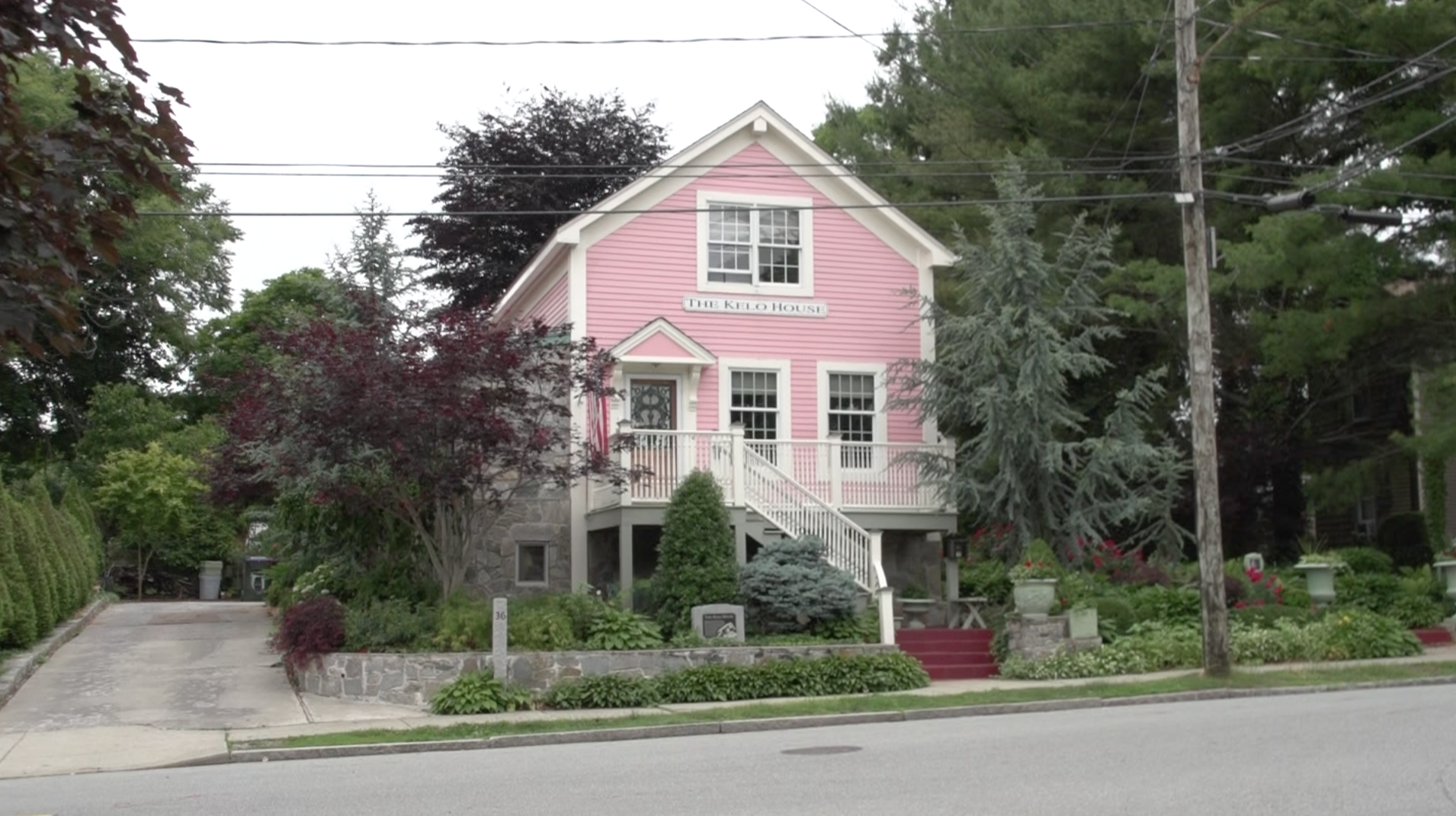NEW LONDON, Conn.—All Susette Kelo wanted was to live with a view of the water.
In 1997, Kelo achieved her dream with the purchase of a 900-square foot Victorian home located in the Fort Trumbull neighborhood of New London, Conn.
The home enveloped her when she walked through the front door for the first time, like she had lived there her entire life. And when Kelo bought the home, she painted it pink—Odessa Rose from Benjamin Moore’s historic collection, Kelo specifically remembers.
From her front porch, the mother of five boys could see the mouth of the Thames River. On a clear day, she could see all the way to Montauk Point on New York’s Long Island.
But less than one year after moving to her piece of paradise, Kelo found out the city of New London wanted to take her waterfront property and others belonging to her Fort Trumbull neighbors.
The city used its power of eminent domain.
And so she, along with six other families who owned 15 properties in Fort Trumbull, fought back.
“When I first started this battle, it was about me and this little pink house,” Kelo told The Daily Signal. “But it grew into something much bigger than that. It turned into a nationwide battle to save the Fort Trumbull neighborhood.”
Kelo and her fellow plaintiffs—Thelma Brelesky, Pasquale Cristofaro, Wilhelmina and Charles Dery, James and Laura Guretsky, Richard Beyer and Bill von Winkle—fought the city of New London to keep their homes. The city wanted to transfer the property to a private nonprofit organization, which would facilitate its development.
Their fight went all the way to the United States Supreme Court, which ruled against the property owners on June 23, 2005.
Though Kelo and her neighbors lost, the case became one of the most contested in the high court’s history, and it sparked reform in the vast majority of the states.
But the land where their homes once stood remains vacant, now a decade later.
The city spent $78 million bulldozing the homes and preparing the area for development, but so far, all plans have fallen through.
“They put in infrastructure and roads to nowhere, sidewalks to nowhere with always the thought that they were going to have this redevelopment plan where a hotel would come, a health club, cafes, restaurants and stuff like that that never came to be,” Kelo told The Daily Signal.
And for Kelo and Michael Cristofaro—who grew up in the Fort Trumbull neighborhood and whose father was one of the plaintiffs in the case—the wounds from their battle with New London haven’t yet healed.
“If you look out, this is what the city of New London wanted,” Cristofaro told The Daily Signal, standing in the Fort Trumbull neighborhood. “This is what they took our homes for—this vast amount of land. This is what the U.S. Supreme Court said that the city of New London was justified in taking our homes—an empty field. As far as I’m concerned, it’s an empty dream.”
>>> Interested in learning more? Read “A Decade After Kelo: Time for Congress to Protect American Property Owners”

Susette Kelo and Institute for Justice lawyer Scott Bullock stand outside the Supreme Court after oral arguments in the case Kelo v. City of New London. (Photo: Institute for Justice)
Fighting Back
Known by its signature pink color, Kelo’s home became the symbol of the battle she and her neighbors waged against the city of New London.
Kelo v. City of New London examined whether the government has the power to take private property for economic development through eminent domain. The Fifth Amendment allows the government to take property from private residents if it satisfies two conditions: it’s for public use and just compensation is provided.
However, over the last few decades, the definition of public use has expanded from seizing property to build a school, bridge or road, to transferring property from one private party to another.
In the Kelo case, the land the Fort Trumbull neighborhood sat on would be transferred from private residents to a private nonprofit group, the New London Development Corporation, which would then develop the property. Plans for the land included a new hotel, restaurants, shops and a renovated marina.
The city hoped redeveloping the neighborhood would boost the local economy and grow its tax base, with the help of a new facility built by Pfizer, the pharmaceutical giant, located adjacent to the property.
The city first tried to convince the Fort Trumbull residents to sell their homes, and many of them did. But seven families, including Kelo—who owned 15 properties combined—pushed back and refused to leave their homes and businesses, many of which had been in their families for generations.
The property owners were threatened by the New London Development Corporation for years. Some residents were locked out of their homes, and others had their water turned off. On more than one occasion, residents would find a bulldozer parked outside their houses. When its engine revved, the structures would shake, Cristofaro remembered.
But Kelo and her neighbors held strong and, with the help of Institute for Justice, took their case from the Superior Court of New London to the Connecticut Supreme Court and all the way to the U.S. Supreme Court.
“Eminent domain is used against the people who the government thinks can’t fight back,” said Dana Berliner, a lawyer with the Institute for Justice who argued the case at the Connecticut Supreme Court. “People need to organize in opposition to eminent domain when it occurs.”
The U.S. Supreme Court ultimately ruled 5-4 against the property owners and argued that states could use eminent domain to take private property for a “public purpose” or to meet a “public need” so long as just compensation is provided.
Now, 10 years after the Supreme Court’s decision, Kelo v. City of New London remains one of the most disputed rulings in the high court’s history.
In the wake of the decision, though, more than 40 states passed laws limiting the use of eminent domain transferring property to a private party for economic development. In 11 of those states, legislatures passed constitutional amendments addressing the Kelo ruling.
>>> Supreme Court Rules Government Can’t Pick and Choose What Speech Is Free
Ten Years Later
Years ago, the Fort Trumbull neighborhood was the type where a kid would run out of his or her back door, through the backyard, and into the home of a neighbor, Cristofaro recalled.
“That’s the kind of neighborhood that you had,” he said. “You didn’t need to worry about your kids. The neighbors looked after your kids.”
The neighborhood was filled with “working class” families, and the property owners took great pride in their homes. The lawns were well-manicured, and many of the homeowners showed off their green thumbs. Cristofaro’s dad, Pasquale, grew rhododendrons and grapes in their yard on Goshen Street.
“That’s one of the things I don’t think people realize about eminent domain,” Cristofaro said. “A lot of people say, ‘Well, it’s just a house. It’s just four walls. Move on. Go find another home and go live.’”
“It’s more than that,” he continued. “It’s the memories of knowing that your children and grandchildren have been stomping around the property, that the markings on the walls where they grew up that you refused to paint over because it’s like, ‘Oh no, that’s my first grandchild, that’s my second grandchild.’ You can’t just say, ‘It’s a material type of thing.’”
In the months after the high court issued its ruling, Kelo had a number of visitors wanting to relive their own memories with her little pink house. She recalled walking out on her front porch one day to find a man staring up at her home. He had been born in the house, he told her.
Another woman traveled with her mother, who was in her 90s, to Fort Trumbull from California. The house once belonged to her grandmother, and she remembered sliding down the bannister as a child. In a third encounter, Kelo recalled taking care of an elderly woman who was married in the home when it belonged to the Bigelow family in the 1950s.
“Your home is your sanctuary,” Kelo said, “and it should be protected by the government so you can have your home and life there, and have your life, your dreams, your memories.”
Now, the land where Cristofaro and Kelo lived—the land where weddings were held and babies were born, and where a multi-year court battle was fought over—remains overgrown with weeds.
The streets surrounding the neighborhood serve as an overflow lot to the employees of General Dynamics’ Electric Boat division, which took over the Pfizer facility after the company left New London in 2009. The employees park their cars around 7 a.m., and by 3:30 p.m., the streets are empty once again.
The only reminders of the homes and businesses that used to make up the sprawling neighborhood are remnants of foundation—a slate of concrete marking the entrance to Charles Dery’s Italian market—and telephone poles lining what used to be Goshen Street.
>>> Court Again Affirms You Have to Intend a Threat for It to Be a Threat
A transformer sits high atop one of those poles, and it’s what Cristofaro uses as a landmark for where his family’s old home sat.
Kelo, who bought her little pink house on the corner of East and Trumbull Streets just months before the city began its crusade to take it, left New London after the Supreme Court ruled against her and her neighbors.
She now lives in Groton, Conn., where on a clear day, she can see the peninsula where her old neighborhood sits from across the Thames River.
“It’s sort of like—it’s not sort of like—it’s a sour note,” she said. “They took our homes by eminent domain … It’s just a hurtful spot.”
Kelo’s home was spared from demolition and moved to 36 Franklin Street. It’s still the signature pink.
“This house, moved from the Fort Trumbull neighborhood, stands as a testament to the bravery of Susette Kelo and her neighbors, and to the thousands of others who have battled and are battling the abuse of eminent domain across the country,” reads a plaque on the front of the house, dedicated in 2008.
Of the six other property owners, only Cristofaro returns, but really just to show out-of-town reporters around the site.
“If I had to bring my kid here and say this was our family homestead growing up, I mean, I have a rock to reference the property. A telephone pole knowing that was the edge of it,” he said. “That’s a shame. That’s totally a shame. They should’ve never taken this property for eminent domain just for private development. That was totally wrong.”
A Future for Fort Trumbull
In 2012, not long after Mayor Daryl Justin Finizio, a Democrat, was elected mayor to New London, he apologized to the residents of Fort Trumbull on behalf of the city.
And though the land remains vacant, he has big plans for the old neighborhood.
“We have not committed the worst sin in eminent domain in the Kelo case until we transfer that property to private development, and that has not happened yet,” Finizio told The Daily Signal.
Instead, the first-term mayor has talked about using the land for what he says is actual“public use”—build water purification facilities, a tiny-house neighborhood filled with green, environmentally friendly homes, a community center or city-run green parking garage in the Fort Trumbull neighborhood.
“There are numerous ways to develop Fort Trumbull and to do it on a way that would also show the country that this spot, where there was a real national embarrassment for the city of New London, could become a national model for how green, sustainable living can be produced in our country,” he said.
For Kelo and Cristofaro, though, they would rather see the land remain empty.
“To us, it’s better that it stays empty because that’s the biggest memorial of all—that it’s empty” Kelo said. “Proof to the pudding.”






























